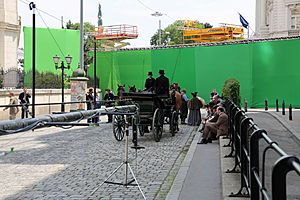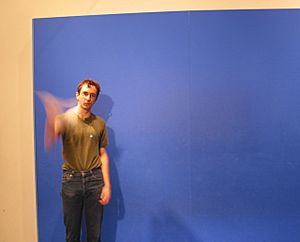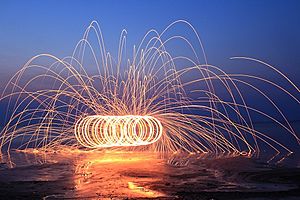Special effect facts for kids


Special effects is a term for the things used in movies to create images that do not exist. There are many different types of special effects, for example, making little models or using computer animation.
Action movies often use special effects to create images that would be dangerous or cost a lot of money to create in real life. For example, if an action movie shows a very big battleship blowing up in flames, it would be expensive to buy a battleship and dangerous to blow it up. For this reason, most action movies use special effects if they want to show something blowing up in flames. A movie maker could make a little model of a battleship that is only a few yards or meters long, and then blow it up while filming with the motion picture camera. This would be cheaper and safer.
Science fiction movies also often use special effects. They usually tell imaginary stories that take place in the future, on other planets. It would be impossible to actually make a science fiction movie on another planet. For this reason, filmmakers use special effects to create images that look like other planets. For example, for a science fiction movie about a world with three suns, the filmmaker could hire computer experts to create an image of three suns which would appear in the background of the movie scenes.
Mechanical effects (also called practical or physical effects) are usually accomplished during the live-action shooting. This includes the use of mechanized props, scenery, scale models, animatronics, pyrotechnics and atmospheric effects: creating physical wind, rain, fog, snow, clouds, making a car appear to drive by itself and blowing up a building, etc. Mechanical effects are also often incorporated into set design and makeup. For example, prosthetic makeup can be used to make an actor look like a non-human creature.
Optical effects (also called photographic effects) are techniques in which images or film frames are created photographically, either "in-camera" using multiple exposure, mattes or the Schüfftan process or in post-production using an optical printer. An optical effect might be used to place actors or sets against a different background.
Since the 1990s, computer-generated imagery (CGI) has come to the forefront of special effects technologies. It gives filmmakers greater control, and allows many effects to be accomplished more safely and convincingly and—as technology improves—at lower costs. As a result, many optical and mechanical effects techniques have been superseded by CGI.
Images for kids
-
Publicity still for the 1933 film King Kong, which used stop-motion model special effects
See also
 In Spanish: Efectos especiales para niños
In Spanish: Efectos especiales para niños





